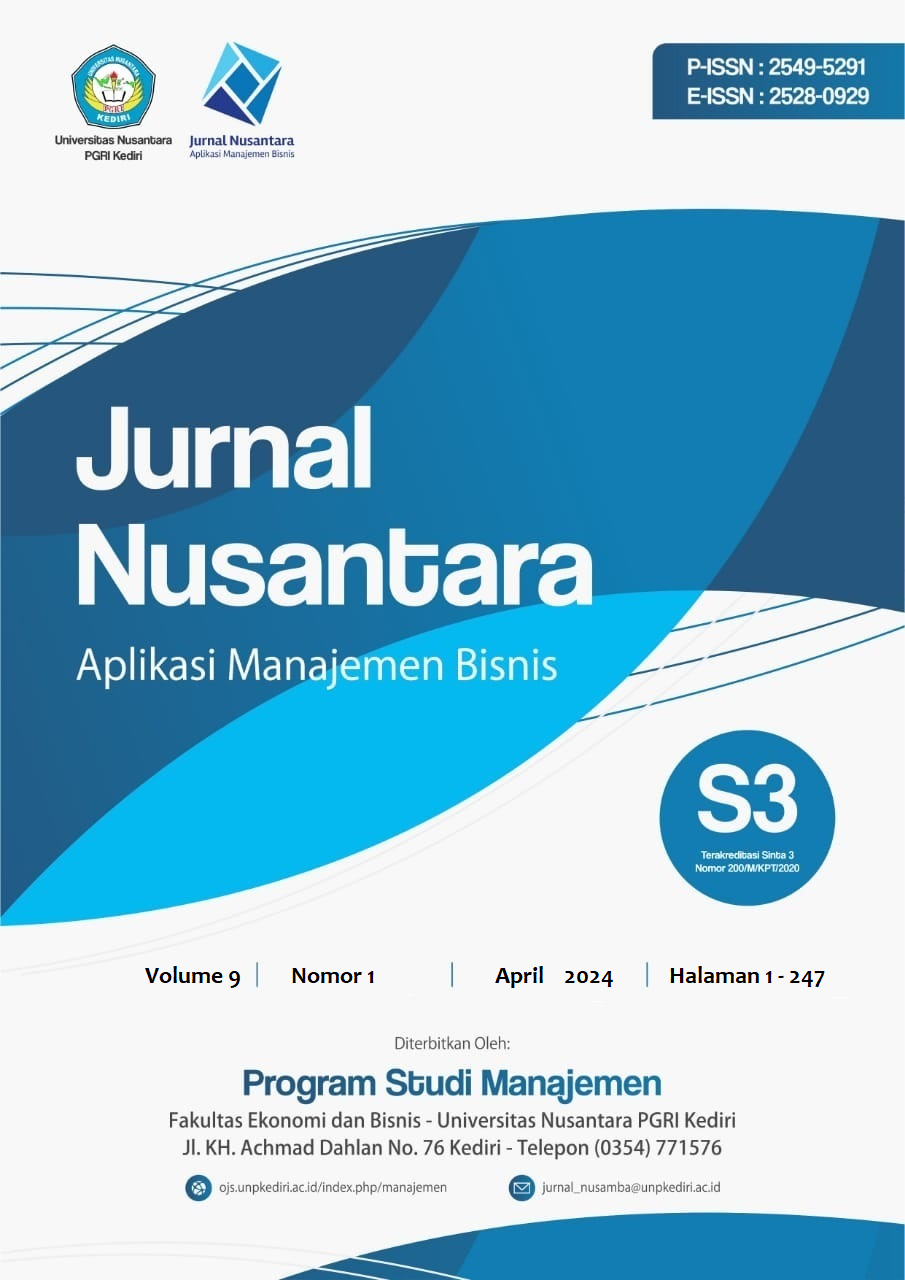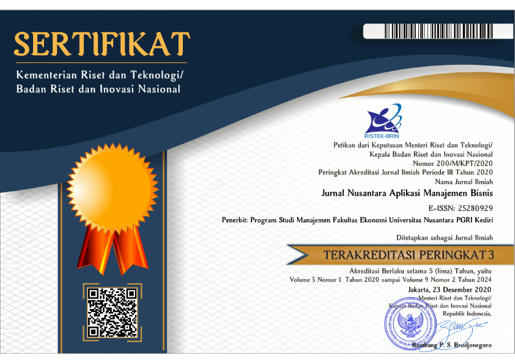Menuju Nol Limbah: Eksplorasi Motif Pilihan Makanan dan Dampaknya terhadap Minimisasi Sisa Makanan oleh Konsumen Restoran
DOI:
https://doi.org/10.29407/nusamba.v9i1.20931Keywords:
Limbah Makanan, Pariwisata Berkelanjutan, Restoran HijauAbstract
Research aim: The study aims to examine the effect of food choice motives on consumers’ intention to avoid food waste in casual restaurants.
Methods: This current study utilizes a quantitative approach with a Structural Equation Model (SEM) and through the perspective of planned behavior theory.
Research Finding: It is found that 4 food choice motives have a positive and significant influence on consumers’ intention to avoid food waste in casual restaurants.
Theoretical contribution/Originality: It is the first study in Indonesia examining the influence of food choice motives on consumers’ intention to avoid food waste in the casual restaurant (rumah makan) setting
Practitioner/Policy implication: This research offers managerial implications that can be utilised by restaurants to develop environmentally friendly programs.
Research limitation : It needs to include the context of online food delivery apps that facilitate consumers to buy food at restaurants and consume it at home.
Downloads
References
United Nations Environment Programme, “Food Waste Index Report 2021,” Nairobi, 2021.
The Economist Intelligence Unit, “Fixing Food: Towards a More Sustainable Food System,” 2016.
Bappenas, “Food Loss and Food Waste di Indonesia,” 2021.
S. Gössling, B. Garrod, C. Aall, J. Hille, and P. Peeters, “Food management in tourism: Reducing tourism’s carbon ‘foodprint,’” Tour. Manag., vol. 32, no. 3, pp. 534–543, Jun. 2011.
European Environment Agency, “What are the source of food waste in europe?,” 2020. [Online]. Available: https://www.eea.europa.eu/media/infographics/wasting-food-1/view. [Accessed: 16-May-2023].
A. Dhir, S. Talwar, P. Kaur, and A. Malibari, “Food waste in hospitality and food services: A systematic literature review and framework development approach,” J. Clean. Prod., vol. 270, p. 122861, Oct. 2020.
B. Okumus, “How do hotels manage food waste? evidence from hotels in Orlando, Florida,” J. Hosp. Mark. Manag., vol. 29, no. 3, pp. 291–309, Apr. 2020.
K. R. Curtis and S. L. Slocum, “The Role of Sustainability Certification Programs in Reducing Food Waste in Tourism,” J. Dev. Sustain. Agric., vol. 11, pp. 1–7, 2016.
U. Gretzel, J. Murphy, J. Pesonen, and C. Blanton, “Food waste in tourist households: a perspective article,” Tour. Rev., vol. 75, no. 1, pp. 235–238, Feb. 2020.
A. de Visser-Amundson, “A multi-stakeholder partnership to fight food waste in the hospitality industry: a contribution to the United Nations Sustainable Development Goals 12 and 17,” J. Sustain. Tour., vol. 30, no. 10, pp. 2448–2475, Oct. 2022.
E. Närvänen, N. Mesiranta, M. Mattila, and A. Heikkinen, Food Waste Management. Cham: Springer International Publishing, 2020.
J. Murphy, U. Gretzel, J. Pesonen, and A.-L. Elorinne, “Wicked Problem: Reducing Food Waste by Tourist Households,” J. Gastron. Tour., vol. 3, no. 4, pp. 247–260, Jul. 2019.
L. G. Block et al., “The Squander Sequence: Understanding Food Waste at Each Stage of the Consumer Decision-Making Process,” J. Public Policy Mark., vol. 35, no. 2, pp. 292–304, Sep. 2016.
J. Aschemann-Witzel, I. de Hooge, P. Amani, T. Bech-Larsen, and M. Oostindjer, “Consumer-Related Food Waste: Causes and Potential for Action,” Sustainability, vol. 7, no. 6, pp. 6457–6477, May 2015.
S. V. Russell, C. W. Young, K. L. Unsworth, and C. Robinson, “Bringing habits and emotions into food waste behaviour,” Resour. Conserv. Recycl., vol. 125, pp. 107–114, Oct. 2017.
M. Hurst, H. Dittmar, R. Bond, and T. Kasser, “The relationship between materialistic values and environmental attitudes and behaviors: A meta-analysis,” J. Environ. Psychol., vol. 36, pp. 257–269, Dec. 2013.
C.-C. Teng, Y.-C. Wang, and C.-J. Chuang, “Food choice motives and dining-out leftover prevention behavior: Integrated perspectives of planned behavior and norm activation,” Int. J. Hosp. Manag., vol. 107, no. May 2021, p. 103309, Oct. 2022.
J. de Boer, C. T. Hoogland, and J. J. Boersema, “Towards more sustainable food choices: Value priorities and motivational orientations,” Food Qual. Prefer., vol. 18, no. 7, pp. 985–996, Oct. 2007.
M. M. Jeon, S. (Ally) Lee, and M. Jeong, “e-Social Influence and Customers’ Behavioral Intentions on a Bed and Breakfast Website,” J. Hosp. Mark. Manag., vol. 27, no. 3, pp. 366–385, Apr. 2018.
I. Ajzen and T. J. Madden, “Prediction of goal-directed behavior: Attitudes, intentions, and perceived behavioral control,” J. Exp. Soc. Psychol., vol. 22, no. 5, pp. 453–474, Sep. 1986.
M. C. Onwezen, M. J. Reinders, M. C. D. Verain, and H. M. Snoek, “The development of a single-item Food Choice Questionnaire,” Food Qual. Prefer., vol. 71, pp. 34–45, Jan. 2019.
H. C. M. van Trijp and A. R. H. Fischer, “Mobilizing consumer demand for sustainable development,” in The TransForum Model: Transforming Agro Innovation Toward Sustainable Development, Dordrecht: Springer Netherlands, 2010, pp. 73–96.
V. H. M. Visschers, N. Wickli, and M. Siegrist, “Sorting out food waste behaviour: A survey on the motivators and barriers of self-reported amounts of food waste in households,” J. Environ. Psychol., vol. 45, pp. 66–78, Mar. 2016.
C. Tobler, V. H. M. Visschers, and M. Siegrist, “Eating green. Consumers’ willingness to adopt ecological food consumption behaviors,” Appetite, vol. 57, no. 3, pp. 674–682, Dec. 2011.
M. Verain, S. Sijtsema, H. Dagevos, and G. Antonides, “Attribute Segmentation and Communication Effects on Healthy and Sustainable Consumer Diet Intentions,” Sustainability, vol. 9, no. 5, p. 743, May 2017.
F. Abdelradi, “Food waste behaviour at the household level: A conceptual framework,” Waste Manag., vol. 71, pp. 485–493, 2018.
D. M. A. Roodhuyzen, P. A. Luning, V. Fogliano, and L. P. A. Steenbekkers, “Putting together the puzzle of consumer food waste: Towards an integral perspective,” Trends Food Sci. Technol., vol. 68, pp. 37–50, Oct. 2017.
I. Ajzen, “The theory of planned behavior,” Organ. Behav. Hum. Decis. Process., vol. 50, no. 2, pp. 179–211, Dec. 1991.
K. M. Appleton et al., “Liking and consumption of vegetables with more appealing and less appealing sensory properties: Associations with attitudes, food neophobia and food choice motivations in European adolescents,” Food Qual. Prefer., vol. 75, pp. 179–186, 2019.
S. Korzen and J. Lassen, “Meat in context. On the relation between perceptions and contexts,” Appetite, vol. 54, no. 2, pp. 274–281, 2010.
C. Göbel, N. Langen, A. Blumenthal, P. Teitscheid, and G. Ritter, “Cutting Food Waste through Cooperation along the Food Supply Chain,” Sustainability, vol. 7, no. 2, pp. 1429–1445, Jan. 2015.
T. E. Quested, E. Marsh, D. Stunell, and A. D. Parry, “Spaghetti soup: The complex world of food waste behaviours,” Resour. Conserv. Recycl., vol. 79, pp. 43–51, 2013.
A. Steptoe, T. M. Pollard, and J. Wardle, “Development of a Measure of the Motives Underlying the Selection of Food: the Food Choice Questionnaire,” Appetite, vol. 25, no. 3, pp. 267–284, Dec. 1995.
M. Lindeman and M. Väänänen, “Measurement of ethical food choice motives,” Appetite, vol. 34, no. 1, pp. 55–59, Feb. 2000.
R. Bougie and U. Sekaran, Research methods for business : a skill-building approach , Eighth edi. Hoboken, NJ: John Wiley & Sons, Inc., 2020.
J. F. Hair, G. T. M. Hult, C. M. Ringle, and M. Sarstedt, A Primer on Partial Least Squares Structural Equation Modeling (PLS-SEM), Third. Los Angeles: Sage Publications India Pvt. Ltd, 2022.
D. Barclay, R. Thompson, and C. Higgins, “The Partial Least Squares (PLS) Approach to Causal Modeling: Personal Computer Use as an Illustration,” Technol. Stud., vol. 2, Jan. 1995.
H. G. Parsa, B. K. Shuster, and M. Bujisic, “New Classification System for the U.S. Restaurant Industry: Application of Utilitarian and Hedonic Continuum Model,” Cornell Hosp. Q., vol. 61, no. 4, pp. 379–400, Nov. 2020.
J. F. Hair, J. J. Risher, M. Sarstedt, and C. M. Ringle, “When to use and how to report the results of PLS-SEM,” Eur. Bus. Rev., vol. 31, no. 1, pp. 2–24, Jan. 2019.
I. Ghozali, Structural equation modeling dengan metode alternatif partial least square (PLS), 5th ed. Semarang: Badan Penerbit Universitas Diponegoro, 2021.
I. E. de Hooge, M. Oostindjer, J. Aschemann-Witzel, A. Normann, S. M. Loose, and V. L. Almli, “This apple is too ugly for me!,” Food Qual. Prefer., vol. 56, pp. 80–92, Mar. 2017.
F. Abdelradi, “Food waste behaviour at the household level: A conceptual framework,” Waste Manag., vol. 71, pp. 485–493, Jan. 2018.
P. Werf, J. A. Seabrook, and J. A. Gilliland, “Food for naught: Using the theory of planned behaviour to better understand household food wasting behaviour,” Can. Geogr. / Le Géographe Can., vol. 63, no. 3, pp. 478–493, Sep. 2019.
D. Aune et al., “Fruit and vegetable intake and the risk of cardiovascular disease, total cancer and all-cause mortality—a systematic review and dose-response meta-analysis of prospective studies,” Int. J. Epidemiol., vol. 46, no. 3, pp. 1029–1056, Jun. 2017.
J. Wang et al., “Food Waste Behaviours at Buffet Restaurants in China,” IOP Conf. Ser. Earth Environ. Sci., vol. 690, no. 1, p. 012016, Mar. 2021.
Y. Zhao and F. Bacao, “What factors determining customer continuingly using food delivery apps during 2019 novel coronavirus pandemic period?,” Int. J. Hosp. Manag., vol. 91, p. 102683, Oct. 2020.
Downloads
Published
Issue
Section
License
Authors who publish with this journal agree to the following terms:
- Copyright on any article is retained by the author(s).
- The author grants the journal, the right of first publication with the work simultaneously licensed under a Creative Commons Attribution License that allows others to share the work with an acknowledgment of the work’s authorship and initial publication in this journal.
- Authors are able to enter into separate, additional contractual arrangements for the non-exclusive distribution of the journal’s published version of the work (e.g., post it to an institutional repository or publish it in a book), with an acknowledgment of its initial publication in this journal.
- Authors are permitted and encouraged to post their work online (e.g., in institutional repositories or on their website) prior to and during the submission process, as it can lead to productive exchanges, as well as earlier and greater citation of published work.
- The article and any associated published material is distributed under the Creative Commons Attribution-ShareAlike 4.0 International License












